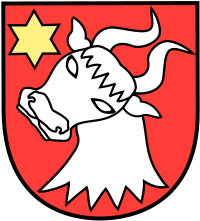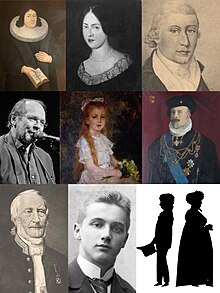| Paus | |
|---|---|
 | |
 Family members from the 17th to the 21st centuries: priest Hans Paus; Aase Paus; shipowner Ole Paus; singer Ole Paus; Helvig Paus; count Christopher Paus; governor Christian Cornelius Paus; lawyer and mountaineer George Wegner Paus; lawyer Henrik Johan Paus and Hedevig Paus (Ibsen's grandmother) | |
| Current region | Norway, Sweden, Denmark, United Kingdom, Switzerland |
| Earlier spellings | Pausius (Latinized), de Paus (internationally), von Paus (Austria only) |
| Etymology | from Middle Saxon/Middle Dutch paus, paues, pauwes, "pope", perhaps applied as a nickname for someone renowned for his piety |
| Place of origin | Known in Oslo, Norway since the 16th century |
The Paus family (pronounced [ˈpæʉs]) is a prominent Norwegian family with a long history of involvement in the clergy and governance elite, nobility, industry, and the arts. The family first emerged as members of the elite of 16th-century Oslo and, for centuries, belonged to Norway's "aristocracy of officials," especially in the clergy and legal professions in Upper Telemark. Later generations became involved in shipping, steel, and banking, establishing themselves as steel magnates in Christiania (Oslo) during the Second Industrial Revolution. The family's most famous members are playwright Henrik Ibsen[a][1][2] and singer Ole Paus.
Two brothers from Oslo who both became priests, Hans (1587–1648) and Peder Povelsson Paus (1590–1653), have long been known as the family's earliest certain ancestors. In his book Slekten Paus, S.H. Finne-Grønn traced the family two further generations back, to Hans Olufsson (died 1570), a high-ranking member of the royal clergy who held the rank of a knight, the highest rank of nobility in Norway at the time.[3][4] The name Paus, believed to be of Middle Saxon or Middle Dutch origin,[5] is known in Oslo since the 14th century, notably as the name of the Lawspeaker of Oslo Nikolas Paus (mentioned 1329–1347) and as the name of one of medieval Oslo's "city farms", Pausinn (mentioned 1324–1482). The extant family is descended from Peder Povelsson Paus, who was provost of Upper Telemark from 1633. From the 17th to the 19th century, the family were among the foremost of the regional elite, the "aristocracy of officials" in Upper Telemark,[1] where many family members served as priests of the state church, judges and other government officials and where several state and church offices in practice were hereditary in the family for extended periods. For example, the office of governor/chief district judge (sorenskriver) of Upper Telemark—the region's senior government official—was continuously held by the family for 106 years (1668–1774) and passed on in an hereditary manner.
From the late 18th century family members successively established themselves as ship's captains, shipowners, wealthy merchants and bankers in the port towns of Skien and Drammen. From the 19th century several family members were prominent as steel industrialists in Christiania; other family members founded the industrial company Paus & Paus in Drammen and Oslo. Family members have also owned or co-owned several other major companies, including Norway's largest shipping company Wilh. Wilhelmsen. Since the early 20th century family members have owned half a dozen estates and castles in Sweden, of which the estates Herresta and Näsbyholm in Södermanland are still owned by the family; the Herresta/Näsbyholm branch is descended from Tatiana Tolstoy-Paus, Leo Tolstoy's last surviving grandchild. Christopher Paus, a papal chamberlain and heir to one of Norway's largest timber companies who donated the Paus collection of classical sculpture to the National Gallery, was conferred the title of count by Pope Pius XI in 1923. A village in India, Pauspur, was named in honour of the family in the 19th century. Family members living in Italy and Austria-Hungary from the 19th century spelled the name de Paus or von Paus.[b]
The family's best known descendant is the playwright Henrik Ibsen. Both of his parents belonged to the family in either a biological or social sense. Through the Paus family, their closest relatives, Ibsen's parents had been raised as "near-siblings."[a] Ibsen named or modelled various characters after family members. Episodes and motifs in several of Ibsen's dramas—notably Peer Gynt, Ghosts, An Enemy of the People, The Wild Duck, Rosmersholm, and Hedda Gabler—were inspired by Paus family traditions and real events that took place in the closely intertwined households of the siblings Ole Paus and Hedevig Paus in the early 19th century. The Paus family figures in Ibsen studies, and Jon Nygaard has argued that the emergence of "the new Puritan state of the officials" with the spirit of "Upper Telemark, the Paus family" is a major theme in Ibsen's work.[7] Modern family members include the troubadour Ole Paus and his son, the composer Marcus Paus. Family members live in Norway, Sweden, Denmark, the U.K. and Switzerland. In the course of its history, family members have used multiple seals and coats of arms, including a crane in its vigilance in the seal of Povel Paus on the 1661 Sovereignty Act and a bull's head with golden star used since the 19th century.
Cite error: There are <ref group=lower-alpha> tags or {{efn}} templates on this page, but the references will not show without a {{reflist|group=lower-alpha}} template or {{notelist}} template (see the help page).
- ^ a b Jon Nygaard (2013). "...af stort est du kommen." Henrik Ibsen og Skien. Centre for Ibsen Studies. ISBN 9788291540122
- ^ Jørgen Haave (2017). Familien Ibsen. Museumsforlaget.
- ^ Cite error: The named reference
SNLwas invoked but never defined (see the help page). - ^ Cite error: The named reference
Finne-Grønnwas invoked but never defined (see the help page). - ^ Cite error: The named reference
Vekawas invoked but never defined (see the help page). - ^ Johan Kielland Bergwitz, Henrik Ibsen i sin avstamning: norsk eller fremmed?, Gyldendal Norsk Forlag, 1916
- ^ Nygaard, Jon (2012). "Henrik Ibsen og Skien: '... af stort est du kommen, og till stort skalst du vorde engang!'". Bøygen. 24 (1): 81–95